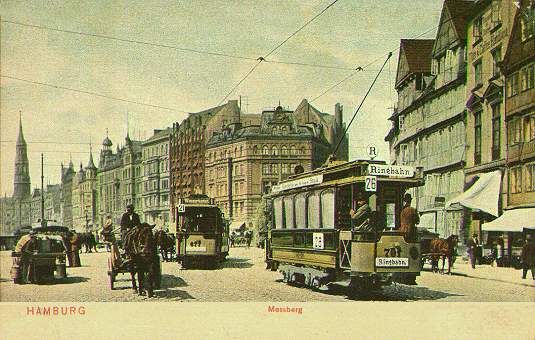

The city of Hamburg in northern Germany has long been a centre of Baltic trade and still keeps its old title of 'Freie Hansestadt Hamburg' ('Free Trading Town of Hamburg') derived from the founding of the Hanseatic League in the Middle Ages. Since those times, it has been one of the wealthiest and populous cities of Germany and it comes as no surprise to learn that Hamburg was the second city in the country to have a tramway. In summary, the standard gauge horse tramway started in 1866, only one year after Berlin, and a separate steam tramway was in operation between 1878 and 1897. The first electric tram service ran on 5th March 1894 although the first electric tram in Hamburg actually ran as early as 1886. However, this was only a short-lived experiment with a battery-operated tramcar that was not deemed successful.
The original horse tramway company, the "Pferde-Eisenbahn-Gesellschaft Hamburg" (or PEG) and the other local horse tram and horse bus companies were formed into the "Grossen Strassenbahn-Eisenbahn-Gesellschaft" (SEG) in 1880. By 1890, the Hamburg tramway system had 19 steam trams, over 450 horse trams and 3,600 horses (including those required for a relatively small fleet of horse buses).
A curiosity was the horse tramway operating from 1878 to 1896 between Hamburg and its western district of Altona. The trams here had five wheels - four on the road and a fifth that was lowered into a slotted guide rail.
The Ringbahn route was the first to be converted from horse power to electric tram operation, rapidly followed by many others although the last horse trams survived until 1922. The mainstay of the electric fleet from 1894 was the so-called 'Z1' car. These cars were double-ended, four-wheel trams built in Hamburg by Waggonfabrik Falkenried and were 8.94m (29ft) long, 2m (6ft 6in) wide, with a wheelbase of 2.20m (7ft 3in) and had a weight of 9 tons. Within two years of electrification, over 400 such cars were in service. The cars were painted in a livery of dark green and ivory with ornate numerals and extensive lining typical of the period.
Originally, these cars were very low powered being fitted with just one 10.2 kW (14 hp) motor giving a top speed of 18 km/h (11 mph) but a speed of only 6 km/h (4 mph) was imposed in the city centre during rush-hours! Over the years from late 1895, the cars were upgraded with two motors of ever-increasing power to allow for higher service speeds and the hauling of trailers. The most powerful cars were ultimately fitted with two 37 kW (50 hp) motors. Also originally, car heating for the cold north German winters was provided by solid fuel stoves but electric heaters using traction current replaced these relatively quickly.
Our postcard is number 238 in an extensive and attractive Hamburg series by the well-known Leipzig publisher Dr. Trenkler Co. and shows Z1 car 701 on the circular Ringbahn route (signified as 'R', but also as route no.26) at Messberg in 1905 with tram 677 hauling a trailer on route 21 to Wasserkunst coming towards the camera on the left. (Incidentally, Hamburg was the first German city to use route numbers for its tramway services). The view is looking west along Dovenfleet with the tower of the St.Katherinen Church on the extreme left. Just out of view on the left is the Zollcanal forming part of the large docks. This whole area and much of Hamburg were destroyed in the Second World War (1943) but the tramway somehow survived and the St.Katherinen Church was rebuilt in its original form of 1659.
Nearly one hundred of the elegant 19th century Z1 cars were still in service in 1959, having survived the destruction of 1943, but by 1961 all but one had been scrapped. From 1952, the tramway, by then operating under the name of Hamburger Hochbahn AG, started to be re-equipped with modern bogie cars in a red and cream livery and they became the mainstay of the fleet until abandonment on 1st October 1978. From the beginning until the end, current collection was only ever by trolley pole and Hamburg was the last German city to use this method, all others having started with, or soon converted to, bow-collectors or pantographs in their early years.
Today, the location of our card is served by an underground station of route U1 of the Hamburg U-Bahn (underground railway). Perhaps confusingly, this is still operated by the Hamburger Hochbahn AG, wherein Hochbahn translates as 'elevated railway'!
And the car that didn't get scrapped? The sole surviving Z1 car is number 656 of 1894 that remains to be cherished and enjoyed at the Museumseisenbahn Schönberger Strand, about 25km NE of Kiel.
![]() Go to Postcard Of The Month Index
Go to Postcard Of The Month Index